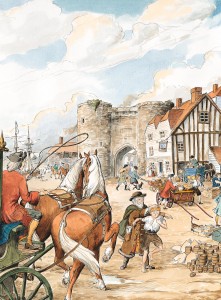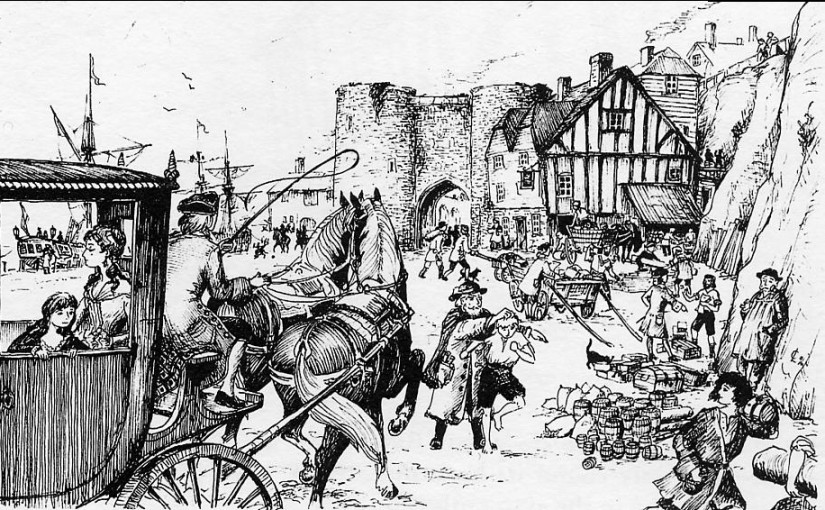By Arthur Woodgate
There is not much doubt that Rye was an exciting place to live when it had a lot more water round and about it and was still complete with all its gates and lots of its walls. The Landgate and the Strandgate were still guarding our little town. It seems to me that although it is recorded that the sea started to recede in the 14th Century, it must have been a slow process through the 15th, 16th and even the 17th.
There were three big gates, and the Postern Gate, which of course, was only for pedestrians and was pulled down in 1767, together with part of the wall to make room for horses and carts, and the stone was used to build a wall round the Church yard. Samual Jeakes recorded that a large part of the town was washed away, (but I can’t find the exact date), together with Baddings Gate, which stood by the Ypres Tower and was joined to the Landgate by a piece of town wall which was also washed away. Landgate was repaired in 1460, because of storm and French damage, and no doubt, was done again a couple of hundred years after because of the Civil war. My Father had a go at it again in 1932 but I don’t think that was anything to do with the French, or the Roundheads and Cavaliers, but may be a few storms. He replaced lots of pieces of stone and re-pointed a lot of it under the direction of the then office of works ancient memorial department, our little town suffered badly from storms and the French (not caused by humans, the storms that is). Today only the Landgate is still standing.
My concern is with Strandgate, which, without doubt, was the most important of all the gates in that it was the gateway to the world, whereas the Landgate had its limits.

We must look at the Strand area again, and we find that under the hard surfaces, there is the type of shingle and pebbles as found along any foreshore, and there is not much doubt that the sea used to lap along the cliffs at South undercliff and the bottom of Mermaid Street. The sea would also have been lapping the cliffs in Military Road. At that time and covering the causeway at High tide, but even if it had been easy to get across there, the Brede Valley would have been too full of sea to have crossed, therefore the only way to get from Rye to Winchelsea was by ferry between the two strands and provision was there for that. There would have been a series of jetties at the Rye Strand to cater for all sorts of ships and boats and at least one would have been reserved for the ferry and there would have been some sort of stage at the Winchelsea Ferry area; so! Strand Gate with its access to the world would have been the main entrance to Rye. Many people would have travelled from other parts of Britain, because it would have been safer than the coach owing to robbers on the roads. The jetties would have been many. It seems the old timers called jetties ‘kitties’ and I have 0heard the five way junction (as it now is) called Kitty Corner.
As Rye; like most of the country had suffered from storms, French raids and Cival War, I am going to hit on about 1660 for my visionary trip up the Main Street from a boat and under Strandgate Arch into what my Grandparents called Strand Hill. I never heard them say Mermaid Street and I have learned that the Mermaid wasn’t always a licensed Inn, but just a boarding house, so when I read that the “George” is Rye’s Oldest Coaching Inn, I was prepared to argue in favour of the Mermaid, but cannot hold that as right and assume that the wide opening into Mermaid Lane is a fake because when I went to School (in Mermaid Street) that opening was narrow and could only take pedestrians. Grandad always went up and down “Strand Hill”.
Rye Royal
In the middle of the 17th Century, I would have got off my boat, gone to the customs office on my right, at the bottom of Strand Hill, then crossed to the Strand Gate and visited the mint for some local coins and then now safely inside the gate, proceeded a few yards to Trader Passage where I would have traded with some of my local coins. Having completed some business in the dealing area of Trader Passage, the rest of the most important street of Strand Hill must be explored. We know, at this time, the Cival War would not long have been over and that Rye had given support to the Roundheads, and that the then Town Clerk was friend of Oliver Cromwell I am going to stop the first person now and just write what I think with existing points still showing as proof. We also know that both the King Charles’s came to Rye and that in 1573 Queen Elizabeth I came and called us “Rye Royal”, so there must have been some fireworks in Strand Hill, but Samuel Jeake kept his town Clerk job and the Jeake family remained in Strand Hill. They were also wool dealers. Having passed the Old Baptist Chapel and manse which was closed in 1909 when their new premises were built in Cinque Ports Street and explored their old burial ground, we now come to what we call Jeakes House, but this was not where the Jeakes family always lived. Their home was what we know as the Old Hospital. They handed it over for a Hospital during the Napoleonic Wars, and moved into their wool store opposite now known as Jeakes House. Later, the Old Hospital turned into a home again and for a while authoress rumour Godden lived in it before she moved to Lamb House. When I was in the Rye Town Band. We used the old School, next to Jeakes House as a practise room, and an owner of the Old Hospital, a Mr Humphrey Ellis used to send us over tea in glasses. He also turned the top story into a club room with all sorts of entertainment and we boy scouts spent many hours up there. Now we come to the Mermaid Inn, which I read, wasn’t always an Inn, so when I was prepared to challenge the statement that the “George Hotel” was the oldest coaching Inn in Rye, I couldn’t. This is no doubt, that when I went to School in Mermaid Street in the 1920’s, the coach width passage through to Mermaid Lane and the Mint was only a narrow, pedestrian width opening. Later, the house next door was bought in, order to widen the passage so we seem to have a fake here, of which Rye has many. It is no fake, however, that the “Mermaid” and the property opposite, called “Robin Hill” were strongholds of the Smugglers & Highwaymen. Anyway, moving further up this famous street, we pass lots of common cottages, many of a great age. These must have all been mixed up in the smuggling business, but I’ve never understood why they had such a variation of ground floor levels. Some have one step up, some one down and then up and down by several. The weather and enemies still couldn’t leave out little town alone right up into the 20th Century, as a flash of lightening struck a chimney on the off licence at Mermaid Street and West Street corner on 1 July 1938 and a few years after Hitler made a gap in the Mermaid Street opposite, and I’m now; in imaginations, about to remove tower house and Norman House, because I’m sure that Strand Hill and market street were once continuous, and I think I can prove this. The West Street tail was just back gardens to the then Market Street cottages except Lamb House would have had a route to its front door. My Mother was born in one of these houses, and as a Schoolboy I was made to scrub Grandmothers back yard and do some shopping and other things for her, so I do know that the backs of those houses had ornamental brickwork and window whereas the fronts were extremely plain and the backs lined up with Strand Hill, so now if we remove the Lion Street School we are lined up with Market Street and passing by the “Red Lion” into Market Street and the new town hall, built in 1742. Having established a straight street running up and over the town, there is no doubt that Strand Hill and Market Street was the main thoroughfare and was paved with boulders all the way down East Street into the High Street and down Hilders Cliff and into the Landgate causeway. To catch a coach one would have had to leave this highway and gone down a then bouidered Lion Street to the “George” coaching station. This is not all, as I am putting forward the idea that the gazebo, we call the tower, in Tower House garden, was something to do with the administration of the town because it had a mate, which would have been the other side of our now discovered ancient street. Beside St. Mary’s cottage, on the West Street – Church Square, there was a square many story building with one room on each floor. It was owned and used by a Miss Mollett and on the ground floor she had a shop, which would sell almost anything, and it was called “The Handsome Pair” and the word “Pair” suggests it had a partner. It is still there, but in the early 1930s, the firm I then worked for, for a contract from Miss Mollett, to add another room to each story, I was sent there to help in spite of a couple of floors having been removed from the top, it is a tower like building. So coming in Rye’s front door, (Strandgate) and up its main street and most important through fare during its period of glory, we would pass between these twin towers into the heart of the town with its market and administration centre, like they were guarding it, and they may have had something to do with it. They may have housed some of the towns documents whilst the new town hall was being built in 1742, because it was reported that the important documents were shared out amongst reliable towns folk. The most treasured list of mayors from 1298 were well looked after. The towers might have given the Council a meeting place during that period.
I think I put up an argument that the Strandgate was more exiting than Landgate and is why I am surprised and disappointed why the Strandgate was allowed to get in bad repair and therefore had to be pulled down in 1815. It had, over its arch, a stone with the borough arms cut in it this was removed and put in the wall of the old customs building, which now is called the “Old Borough Arms”
From May 2008 issue of “Rye’s Own”
All material and pictures on the Rye’s Own Website are subject to strict Worldwide copyright.
